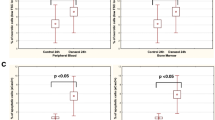Abstract.
Purpose: Troxacitabine (β-L-dioxolane cytidine, BCH-4556; Troxatyl, BioChem Pharma Inc.) is a novel nucleoside analogue, which in experiments demonstrated potent antitumor activity against both leukemias and solid tumors. Since troxacitabine is a cytidine nucleoside analogue like AraC (1-β-D-arabinofuranosylcytosine), which is currently used in the treatment of acute myelogenous leukemia, we compared the in vivo antileukemic activity of troxacitabine with that of AraC in human leukemia xenograft models. Methods: The antiproliferative activity of troxacitabine and AraC was analyzed on hemapoietic cell lines by use of a thymidine incorporation assay. For in vivo studies, we compared troxacitabine with AraC by using equitotoxic schedules of the two nucleosides optimized for therapeutic activity. The antileukemic activity of both drugs was evaluated by measurement of their effect on the percent increased lifespan. Results: AraC had good in vitro antiproliferative activity (IC50=14 nM) but was ineffective in vivo against the HL60 promyelocyte leukemia cell line (treated vs control, T/C=105%). Troxacitabine, which in contrast to AraC is not a substrate for cytidine deaminase, showed potent in vitro and in vivo activity in the same model (IC50=53 nM and T/C=272% to 422%). The poor in vivo activity of AraC against HL60 leukemia cells could be due to the high cytidine deaminase (CDA; EC 3.5.4.5) activity in this cell line. This hypothesis was tested with CCRF-CEM T-lymphoblastoid leukemia cells which have undetectable levels of CDA activity. Short-term exposure of these leukemia cell lines to both drugs indicated that AraC was indeed significantly more effective in the CCRF-CEM cell line than in HL60. In contrast, the antiproliferative activity of troxacitabine was similar for both cell lines. These observations were extended to in vivo studies. Mice bearing CCRF-CEM tumor xenografts were treated with AraC and troxacitabine. In this model, T/C values were comparable for both drugs and ranged from 138% to 157%. Conclusions: Our findings indicate that troxacitabine is likely to be effective not only against solid tumors with high CDA activity but also in leukemias which have developed resistance to AraC due to increased CDA levels; this suggests that troxacitabine is a promising agent for the treatment of cancer. Indeed, significant antileukemic activity has been observed with troxacitabine in a phase I clinical trial in patients with primary refractory or relapsed acute myeloid leukemias (AML).
Similar content being viewed by others
Author information
Authors and Affiliations
Additional information
Electronic Publication
Rights and permissions
About this article
Cite this article
Gourdeau, H., Bibeau, L., Ouellet, F. et al. Comparative study of a novel nucleoside analogue (Troxatyl, troxacitabine, BCH-4556) and AraC against leukemic human tumor xenografts expressing high or low cytidine deaminase activity. Cancer Chemother Pharmacol 47, 236–240 (2001). https://doi.org/10.1007/s002800000223
Received:
Accepted:
Issue Date:
DOI: https://doi.org/10.1007/s002800000223




